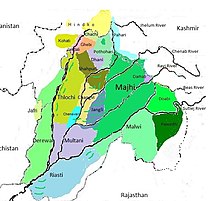
Back പഞ്ചാബി ഭാഷാഭേദങ്ങൾ Malayalam ਪੰਜਾਬੀ ਲਹਿਜੇ Punjabi پنجابی پڑبولیاں PNB पञ्जाबीभाषाः उपभाषाः च Sanskrit پنجابي جا لھجا Sindhi Punjabi dialects and languages SIMPLE பஞ்சாபி கிளைமொழிகள் Tamil పంజాబీ మాండలికాలు Tegulu پنجابی کے لہجے Urdu
| Part of a series on |
| Punjabis |
|---|
 |
 Punjab portal |
The Punjabi dialects (Punjabi: پنجابی بولیاں (Shahmukhi), ਪੰਜਾਬੀ ਬੋਲੀਆਂ (Gurmukhi); romanized: Pañjābī bōlī'ã) or Punjabi varieties (Punjabi: پنجابی قِسماں (Shahmukhi), ਪੰਜਾਬੀ ਕਿਸਮਾਂ (Gurmukhi); romanized: Pañjābī kisamã) are the dialects and varieties of the Punjabi language that are part of the Northwestern Indo-Aryan language group of the Indo-European language family widely spoken in the Punjab region of South Asia. The spoken dialects of Punjabi are mutually intelligible with neighbouring dialects and form a dialect continuum.[1]

They have sometimes been referred to as the Greater Punjabi macrolanguage.[2] Punjabi may also be considered as a pluricentric language with more than one standard variety; almost all standardized varieties of the language are based on the Majhi dialect (Central Punjabi) but with varying influences. Indian Standard Punjabi has more influence from the eastern dialects while standard varieties being cultivated in Pakistan are influenced by the western dialects.[3]
Punjabi, in its various standard forms, dialects and varieties, is spoken by ethnic Punjabis, predominantly in Pakistan and India. It is also spoken by Punjabi diaspora communities around the world.
The varieties of Punjabi have a number of characteristics in common, for example the preservation of the Prakrit double consonants in stressed syllables.[4] During the colonial-era, the classification of Punjabi varieties was a point of debate with some linguists classifying the western dialects as Northwestern and assigning the eastern ones to the Central zone alongside Hindi.[5] In the modern-era, almost all linguists are in an agreement over its classification. Punjabi, as a whole, is classified under Northwestern branch of Indo-Aryan languages, alongside Sindhic.
- ^ "Glottolog 4.8 - Greater Panjabic". glottolog.org. Retrieved 2023-07-13.
- ^ For the use of the term "Greater Panjabi", see Rensch (1992, p. 87) and Rahman (1996, p. 175).
- ^ [1]Muhr, Rudoplh (2016) Pluricentric Languages and Non-Dominant Varieties Worldwide. Peter Lang
- ^ Shackle 2003, p. 591.
- ^ Masica 1991, pp. 446–63.
© MMXXIII Rich X Search. We shall prevail. All rights reserved. Rich X Search